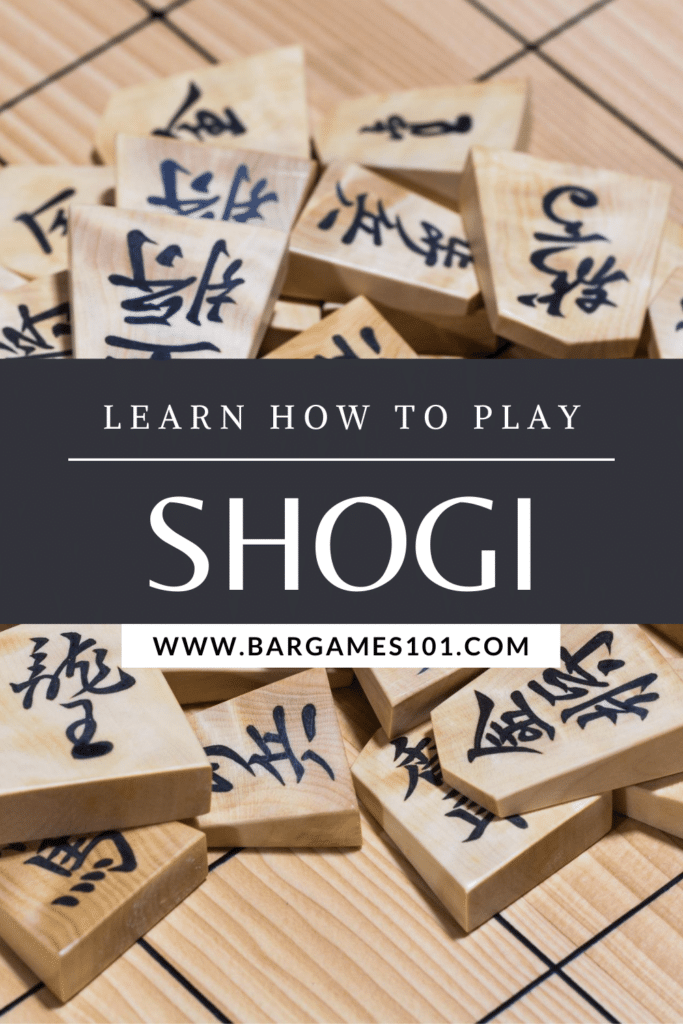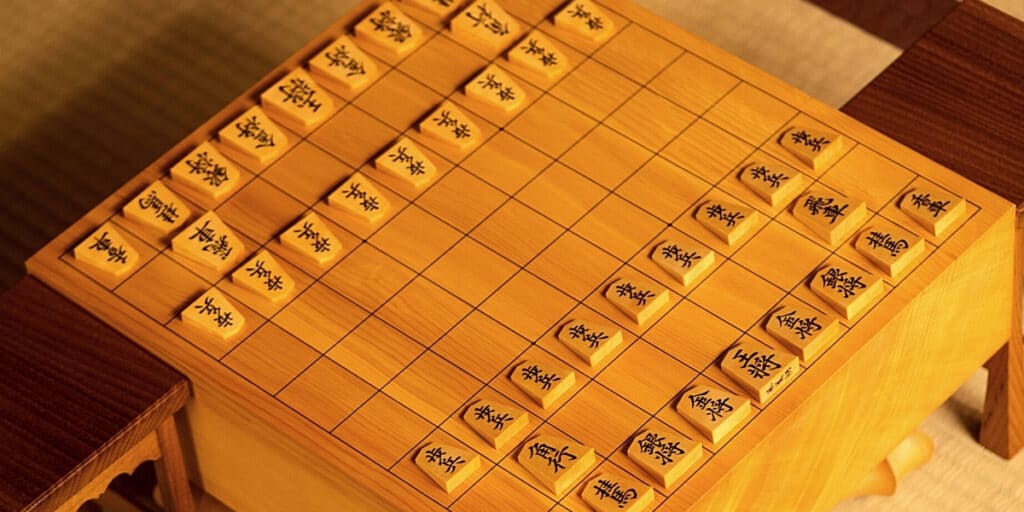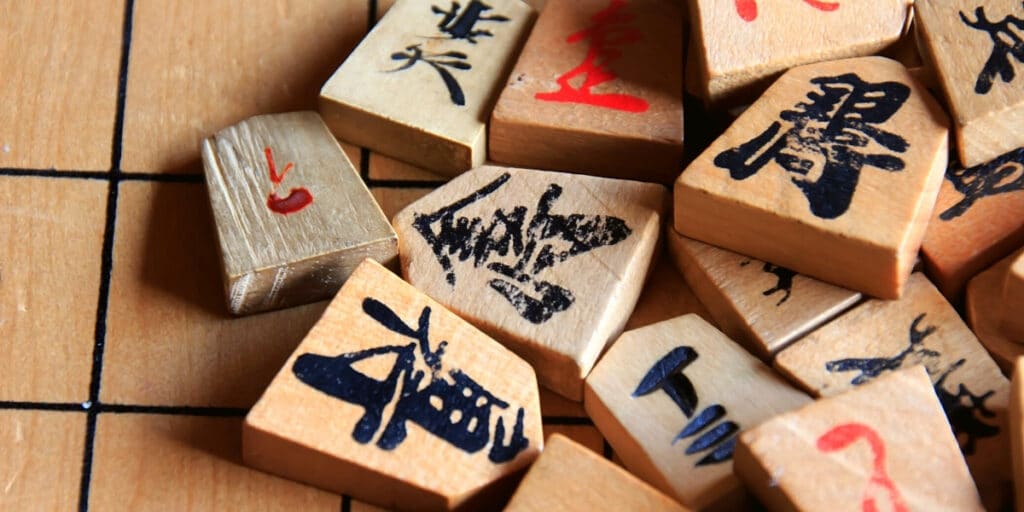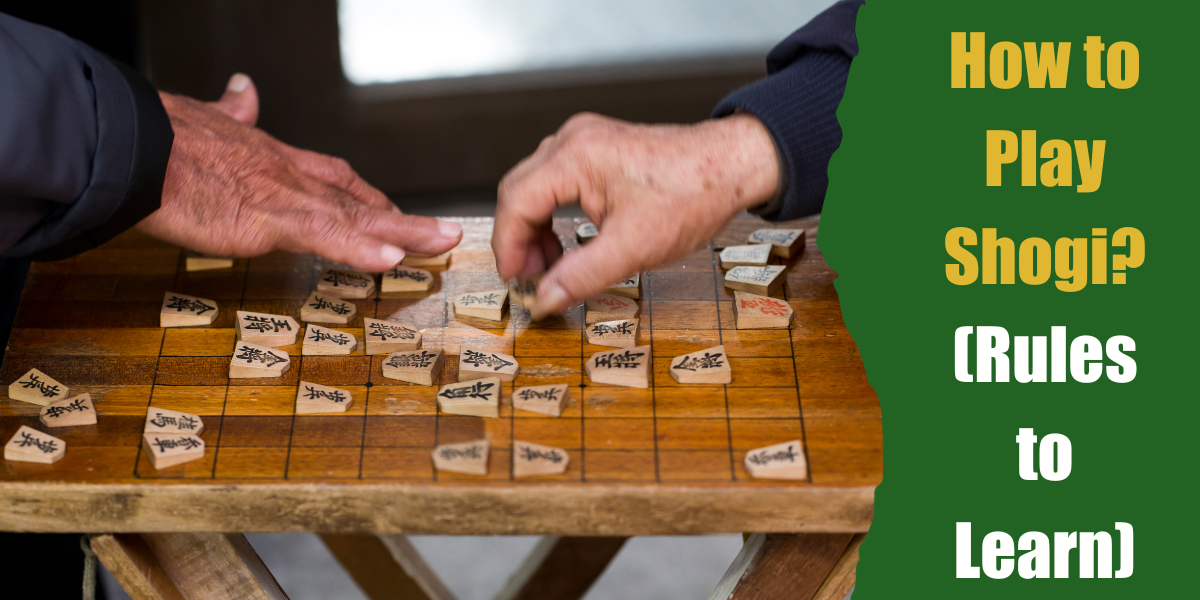This is, The Game of Generals, widely referred to as Japanese Chess, Shogi. A brilliant two-player game of strategy similar to Chess, but also very different. We are going to be teaching you how to play Shogi.

If you enjoy games of strategy such as Chess then Shogi will be right down your alley. There are certainly similarities to be seen but it’s the variations which you may find so interesting, challenging and more importantly, fun..
Before you can learn Shogi, we need to introduce you to the board and the pieces first.
Learn How to Play Shogi
The Setup

The Shogi board is a 9 x 9 board with 81 squares covering it. Each player has 20 pieces with which to play:
- 9 Pawns
- 2 Lances
- 2 Knights
- 2 Silver Generals
- 2 Gold Generals
- 1 Bishop
- 1 Rook
- 1 King
The pieces for both players are not differentiated by color. They simply face one another, though the pieces have a pointed end, which always points in the opponent’s direction.
The placement of the pieces to some degree will be familiar when compared to Chess, however, you will notice some obvious differences.
Across the back row closest to the player and beginning at the corners:
In each corner, place a Lance then the Knights next, followed by the Silver Generals, Gold Generals and finally the King or Jewelled General in the center square.
The next row up from the back only contains two pieces. Both are placed in the square in front of the Knights – or the second square in from the edge.
The third row is simple. Place your nine pawns or foot soldiers in each of the squares.
When both players have set their pieces, you are now ready to play.
The Objective

You may be ready to play; however, what is it that you are trying to do with your pieces? What is the objective when you play Shogi?
Simple, your aim is to achieve a Checkmate. You are moving your pieces forward to capture your opponent’s king.
Easy right? Maybe. Some of the moves will gain you ground and leverage; others will cause you to feel the sting of that leverage slipping away.
You must think before you decide and find a strategy that works for you.
Let’s have a look now and begin to learn Shogi.
How Each Piece Can Be Moved
Like Chess, each of your pieces has a specific maneuverability. Each can be used in their own unique way to help you move forward to capture the king.
One thing to keep in mind is that your pieces do not move backwards. You always have to move them forward, diagonally, or laterally.
Pawns |
You can move your pawns one space forward. |
Lances |
Like your pawns, your Lance can only move forward. However, you may move them forward for any distance. |
Knights |
Your Knight moves two spaces forward and one square to either side. |
Silver Generals |
You can move this piece one space forward or diagonally. |
Gold Generals |
Gold Generals can move one space in any direction except for a backward diagonal move. |
Bishop |
Your Bishop can move diagonally for any number of spaces. |
Rook |
This piece can move forward vertically or horizontally for any number of spaces. |
King |
Just like in Chess, the king can move one space in any direction. |
Now you know how to move your pieces. But there are a few other things you should be aware of before you begin to play.
Promotion

Each piece, other than the king, can be promoted to a more powerful piece if you choose to do so. This is optional with most pieces.
You must consider whether the promotion will allow the piece to continue to move or not.
Promotion can be done when a piece finishes its move and is in the promotion zone – the furthest three rows of spaces away from your piece, or your opponents side of the board.
When you are within the promotion zone and you wish to promote your piece, simply turn it over. The pieces are labeled on both sides.
Here is a list of how each piece promotes:
- Pawns promote to Gold Generals
- Lances promote to Gold Generals
- Knights promote to Gold Generals
- Silver Generals promote to Gold Generals
- Gold Generals do not promote
- Bishop promotes to a Horse or King Bishop – combined moves of King and Bishop
- Rook promotes to Dragon – or King Rook – able to move like a rook or one square diagonally
Suggested: Read our guide on how to play Backgammon.
Dropping and Capturing

A player’s piece is captured when their opponent moves one of their pieces into the same space.
Another attractive characteristic about Shogi is that when a piece is captured, the player who wins it can choose to place that piece back into the game on their next turn. This is called “dropping”.
Essentially using one player’s own pieces against them. The piece being placed back onto the board must be placed where it can still move. It cannot be placed where it is blocked or immovable because it has no legal move it can make.
You also may not drop a piece back into the game as a Checkmate. The dropped piece returns as an unpromoted piece, but it can be promoted on subsequent turns if it is in, or has reached the promotional zone.
The Win

Capturing the king is now up to you. To win the match, this is what you must do. Strategize, and play smart and play fair. Each time you play this fantastic game, you will learn something new.
Go Play
The rules are relatively straightforward. If you enjoy Chess you will most certainly have a great time as you learning how to play Shogi. You will improve your strategies and moves as you practice it.
Now sit down at your Shogi board. Study the pieces and refresh your mind with the maneuvers each piece can make and enjoy yourself.
You won’t become a Shogi master overnight, but you will have a load of fun.
Good luck and have some fun. Go play Shogi.

